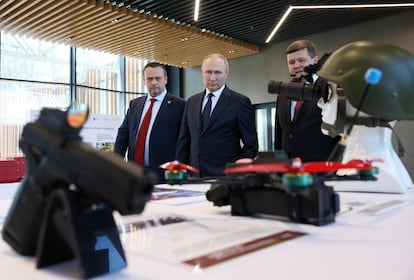The Kremlin’s weakness escalates nuclear risk in Ukraine war
Most experts still see an attack as highly unlikely, but a military and political context that is destabilizing for Vladimir Putin raises troubling uncertainties

Russian President Vladimir Putin made a rare national television address on September 21 to issue new and explicit nuclear threats regarding his faltering invasion of Ukraine. It is not the first time Putin has done this, but Russia’s current circumstances makes his saber-rattling more disturbing than before. Putin leads a nation beset on all sides. His military forces have been pushed back by Ukraine’s successful counteroffensive in the northeast, and have suffered huge casualties and material losses since the invasion began in February. At the international level, Putin faces a united Western bloc and potential allies like China, India and Turkey are currently distancing themselves from Russia. Domestically, the waters are becoming increasingly choppy and murky.
Russia experts are divided on whether Putin would really be willing to resort to nuclear weapons – only the Russian president knows for sure. William Alberque, director of Strategy, Technology, and Arms Control at the International Institute for Strategic Studies, considers nuclear escalation highly unlikely. “I see it [Putin’s threats] as a symptom of weakness and an attempt to force Europe into negotiations,” said Alberque.
Sidharth Kaushal, of the Royal United Services Institute, agrees that it’s highly unlikely Russia will use nuclear weapons in the Ukraine war. “I think it is a latent threat, designed to create uncertainty. I think that Russia’s fragile international position represents a deterrent factor. It is already quite isolated, and its partners are beginning to demonstrate misgivings. If Russia were to attack with a nuclear weapon, it would find itself in complete isolation, which would be devastating for its economy,” said Kaushal. “I don’t think he would use them. I think the world will not allow it,” said Ukrainian President Volodymir Zelenskyy in an interview with Germany’s BILD TV. The Chinese government also urged restraint following Putin’s threats.
“Still,” said Kaushal, “I think a nuclear attack cannot be ruled out. If Ukraine ultimately destroys the bulk of Russia’s forces, we would be looking at the first defeat of a nuclear power in conventional warfare. This is uncharted territory.” In that sense, some experts don’t consider a nuclear outcome highly improbable. Former NATO leader Rose Gottemoeller expressed her concern about this possibility even before Putin’s speech. Would the Russian leader accept a complete defeat in Ukraine that would lead to the probable collapse of his regime without attempting the riskiest of all last resorts? The uncertainty is frightening, and current events have launched it to the forefront.
The nuclear threat is just one of the Kremlin’s responses to its extreme weakness. Putin also announced the partial mobilization of reserve soldiers, and called for referendums to be held in eastern Ukrainian to vote on annexation by Russia. All of these responses follow the same pattern — when challenged, escalate. In this context, the following are some keys to understanding perhaps the most serious nuclear conflict since the Cuban missile crisis of 1962.
What are the objectives of Putin’s threats? Deterrence
The purpose of mobilizing reservists is to add manpower that can contain the Ukrainian counteroffensive. But mobilizing these forces will be a very slow process, to say the least. It remains to be seen how much and when this mobilization will have an effect on the battlefield. The purpose of the referendums and the nuclear threat, on the other hand, is immediate deterrence. The annexation of Ukrainian territories following referendums held in undemocratic conditions will, in the Kremlin’s logic, formalize the incorporation of Ukrainian territory (besides Crimea) into Russia. Therefore, any attack against these annexed territories would constitute an attack against Russia, which Putin said would be contested with every weapon in his arsenal.
Moscow clearly expects that both measures will factor heavily in the calculations of Kyiv and its Western partners. In a recent analysis of Russia’s nuclear threats, Gustave Gressel, of the European Council on Foreign Relations, pointed out that Russia’s campaign of nuclear signaling has borne some fruit in the early stages of the war. NATO has refrained from direct intervention and Western nations have avoided some forms of military assistance for Ukraine. US intelligence services call Russia’s approach “escalate to de-escalate.” In other words, up the ante in hopes that the adversary will hold back.
In addition to trying to slow down the Ukrainian counteroffensive, the Kremlin may be hoping that nuclear scare tactics will encourage Europe to push for de-escalation through negotiation. In his speech, Putin mentioned that Kyiv has at times shown a constructive attitude in this regard. But without offering any evidence, Putin alleged that the West has encouraged Ukraine to keep on fighting.
Will Russia really use a nuclear weapon? Keys to the doctrine
Putin is the only person that can answer that question, but one of his executive orders provides some clues. “Basic Principles of State Policy of the Russian Federation on Nuclear Deterrence” (June 8, 2020) establishes the following conditions for possible nuclear weapons use by the Russian Federation:
a) arrival of reliable data on a launch of ballistic missiles attacking the territory of the Russian Federation and/or its allies;
b) use of nuclear weapons or other types of weapons of mass destruction by an adversary against the Russian Federation and/or its allies;
c) attack by adversary against critical governmental or military sites of the Russian Federation, disruption of which would undermine nuclear forces response actions;
d) aggression against the Russian Federation with the use of conventional weapons when the very existence of the state is in jeopardy.
At first glance, none of these conditions seems to likely in the near term. But if additional Ukrainian territories are annexed by Russia after the referendums, then Putin could feasibly conjure up an existential threat and justify a nuclear attack under condition d).
Who would make the decision? Putin, but...
Article 18 of the Russian doctrine states that the decision to use nuclear weapons is taken by the President of the Russian Federation. But this power is tempered by the necessary involvement of other figures. “The Russian system gives final authority to the president, but only after consultation with the defense minister and the chief of the General Staff of the Armed Forces,” said Kaushal. “The decision, moreover, must be transmitted for execution precisely to the general staff. This structure comes from Soviet-era systems of balance and control. That’s the way it works in theory. But in practice, in view of the concentration of power in Putin’s hands, it’s unlikely that Shoigu, the defense minister, and Gerasimov, the chief of the General Staff, would oppose an order from Putin.” Still, the mechanism provides some leeway for military insubordination.
What types of nuclear weapons would Russia use? Tactical bombs
There is little doubt among experts that the Kremlin would opt for tactical nuclear warheads that have a lower destructive potential and are delivered by shorter-range vehicles than strategic, intercontinental missile systems.
Tactical nuclear weapons are not the most powerful warheads currently available, but they range widely in their destructive potential. Some are much less powerful than the 15-kiloton bomb dropped on Hiroshima (Japan), while others are equally or more powerful. The US has a 0.3-kiloton bomb in its arsenal, so despite the lack of Russian transparency, it’s reasonable to assume that Moscow also has similar bombs. But both nations also have 100-kiloton weapons.
According to a report by Hans M. Kristensen published by the Stockholm International Peace Research Institute, Russia had a large stockpile of non-strategic nuclear warheads in 2020 – nearly 2,000 – which can be fired from land, air or sea. Some delivery vehicles, such as the nuclear-capable Iskander-M missiles, have been used in the Ukraine war with conventional warheads. Russia has amassed a much larger nuclear arsenal than the West, in order to balance out its inferiority in conventional weapons.
How would Russia use them? To terrorize
Former NATO leader Rose Goettemoeller says there are two potential uses. Russia could drop a bomb in the Black Sea to intimidate and terrorize, or it could launch a low-capacity nuclear warhead against an isolated Ukrainian military infrastructure. It remains to be seen how Ukraine would react to such an attack, but in a recently published article, General Valeriy Zaluzhnyi, commander-in-chief of the Ukrainian Armed Forces, addressed the issue.
“Another factor is the direct threat of the use by Russia… It is hard to imagine that even nuclear strikes will enable Russia to break Ukraine’s will to resist. But the threat that will emerge for the whole of Europe cannot be ignored. The possibility of direct involvement of the world’s leading powers in a “limited” nuclear conflict, bringing closer the prospect of World War III, cannot be completely ruled out either,” wrote Zuluzhnyi.
How would the West respond? It depends on the type of attack
If Russia were to launch a nuclear strike in the Ukraine conflict, the potential consequences are terrifying. US President Joe Biden addressed the issue in his September 21 speech before the United Nations General Assembly. Biden called Putin’s threats “irresponsible,” declaring that a nuclear war cannot be won and must never be fought. As before, Biden avoided inflammatory rhetoric, but he did warn Russia that Washington would respond accordingly. “What they do will define the nature of our response.” He emphatically urged Putin not to explore that path. “It would change the face of war like nothing seen since World War II,” he said. At worst, it could change the face of the planet.
Tu suscripción se está usando en otro dispositivo
¿Quieres añadir otro usuario a tu suscripción?
Si continúas leyendo en este dispositivo, no se podrá leer en el otro.
FlechaTu suscripción se está usando en otro dispositivo y solo puedes acceder a EL PAÍS desde un dispositivo a la vez.
Si quieres compartir tu cuenta, cambia tu suscripción a la modalidad Premium, así podrás añadir otro usuario. Cada uno accederá con su propia cuenta de email, lo que os permitirá personalizar vuestra experiencia en EL PAÍS.
¿Tienes una suscripción de empresa? Accede aquí para contratar más cuentas.
En el caso de no saber quién está usando tu cuenta, te recomendamos cambiar tu contraseña aquí.
Si decides continuar compartiendo tu cuenta, este mensaje se mostrará en tu dispositivo y en el de la otra persona que está usando tu cuenta de forma indefinida, afectando a tu experiencia de lectura. Puedes consultar aquí los términos y condiciones de la suscripción digital.











































